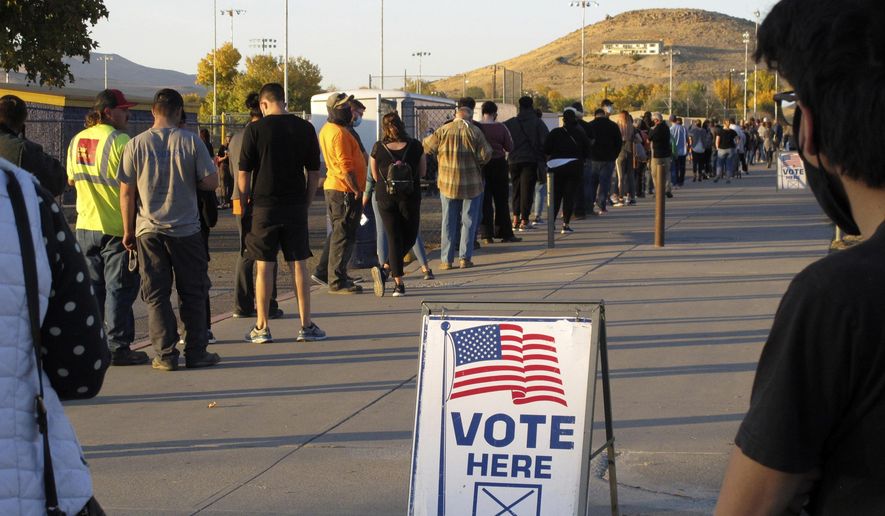Midterm races from Alaska to Maine were decided this year by ranked choice, a system that’s designed to lift up candidates with broad appeal instead of fringe candidates who eke out wins by carving up the electorate.
It’s got its supporters and detractors, but it is growing in popularity across the country after a high-profile tryout in New York City last year. Seven cities or counties voted this month to use ranked choice in future elections and Nevada will opt into the system if a ballot measure passes for a second time in 2024.
Sen. Lisa Murkowski won reelection as a centrist Republican in Alaska late Wednesday after state election officials ran the numbers on ranked choice ballots submitted over a week ago.
She benefited from the large number of votes that were reallocated from Democrat Pat Chesbro, handing her a fourth term as she pulled away from a Trump-backed conservative, Kelly Tshibaka.
“I am honored that Alaskans — of all regions, backgrounds and party affiliations — have once again granted me their confidence to continue working with them and on their behalf in the U.S. Senate,” Ms. Murkowski said in a statement. “I look forward to continuing the important work ahead of us.”
Ranked choice is an election method in which voters rank their preferred candidates instead of just voting for one. If one candidate gets a majority of first-choice votes, he or she wins outright. If not, ranked choice kicks in and the poorest-performing candidates are eliminated, one by one from the bottom, and their votes are reallocated to the second-choice candidates.
The idea is to avoid the so-called “spoiler effect” when more than two candidates run for office, particularly in primaries. The fear is that a weak candidate will slice off enough of the vote to win in a crowded field, yet not be popular overall and perform poorly in a general election.
Ranked choice also seeks a consensus winner without holding a separate — and costly — runoff election, which often results in poor turnout.
Ms. Tshibaka held a slight lead on election night but fell behind after additional ballots were counted in the days that followed. Ms. Murkowski joked about it online.
“And just like that … Kelly’s claim she only lost because of ranked choice was gone,” Ms. Murkowski tweeted with a freeze-frame of a famous scene from “The Usual Suspects.”
Rep. Mary Peltola, a Democrat, fell short of a majority on Election Day but was declared the winner when the ranked choice results were tabulated late Wednesday. She easily held off former Gov. Sarah Palin and Nick Begich III when votes were reallocated from Libertarian candidate Chris Bye.
Alaska and Maine use ranked choice statewide, while Hawaii is slated to use ranked choice in special elections as of 2023. Fifty-six cities use it and Benton County, Oregon, uses it for county commissioner and sheriff elections, according to FairVote, a nonpartisan organization that advocates for ranked-choice voting.
It is a marked increase from 2016 when only 10 cities were using ranked choice.
In Maine, the contest between Democratic Rep. Jared Golden and Republican challenger Bruce Poliquin went to a ranked-choice runoff after neither candidate received 50% of the vote. Elections officials took the 6% of votes that went to independent Tiffany Bond and reallocated those votes to the second-choice candidate on those ballots. Mr. Golden won a majority of second-choice votes on Bond ballots, helping him to victory.
“This Election Day, ranked-choice voting again showed why it’s the fastest-growing nonpartisan voting reform in the country,” FairVote CEO Rob Richie said. “Voters are embracing it from Portland to Portland and New York to Nome, for better choices, better campaigns, and better representation. Everywhere it’s used, voters say they understand and like it — whether in blue, red, or swing parts of the country.”
Critics say ranked-choice voting is too complicated or unfair because the candidate who gets a plurality of first-choice votes might not win in the end. Others feel a traditional runoff between two candidates is beneficial because it requires the last two candidates standing to engage in another round of campaigning.
New York City deployed ranked choice for the first time in the 2021 primaries for mayor. Some voters on the Upper West Side told The Washington Times they had a hard time remembering how they ranked all the candidates or thought the extra choices were superfluous, though others said the system wasn’t too hard to figure out.
Mayor Eric Adams was ahead on election night but barely held off challenger Kathryn Garcia by a single percentage point after the ranked choices were tabulated. Voters could rank up to five choices on their ballots, reducing a field of 13 candidates one by one as the lowest-performing contenders were eliminated and their votes were redistributed.
Virginia Republicans used ranked choice voting to pick 2021 nominees in an “unassembled convention” and had a successful general election cycle headlined by Gov. Glenn Youngkin.
“It looks like Alaska may elect a conservative Republican governor, a moderate Republican senator, and a moderate Democratic congresswoman,” FairVote spokesman Will Mantell said in an email. “Ranked choice voting allows voters to express a wider (and more nuanced) range of preferences.”
• Tom Howell Jr. can be reached at thowell@washingtontimes.com.




Please read our comment policy before commenting.